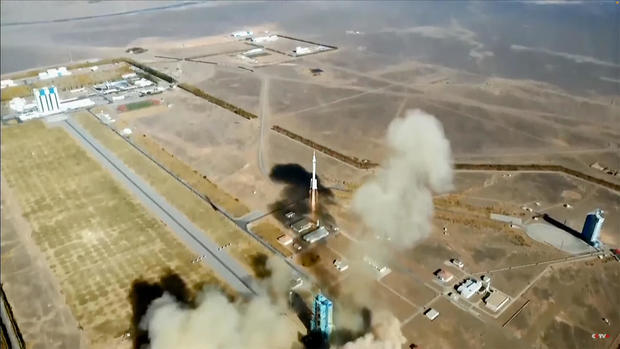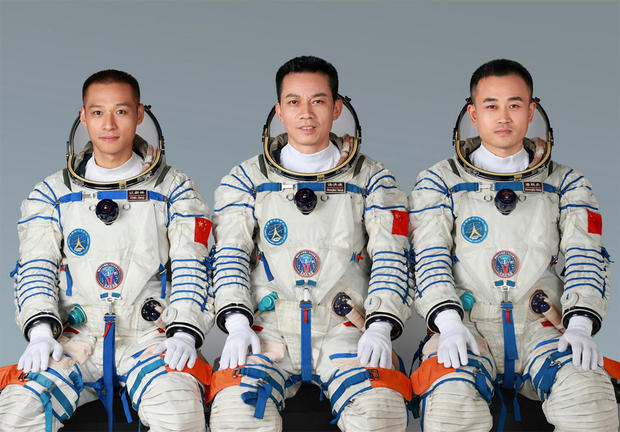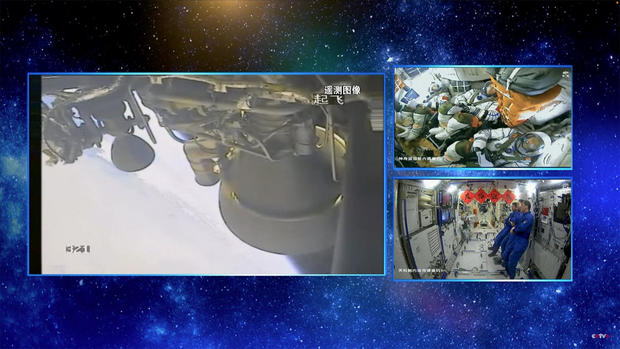China launches fresh 3-man crew to Tiangong space station
China launched a fresh three-man crew to the Tiangong space station Thursday morning to replace three other "taikonauts" who are wrapping up a six-month stay in orbit.
Strapped into their Shenzhou 17 ferry ship atop a Long March 2F rocket, commander Tang Hongbo, Tang Shengjie and Jiang Xinlin blasted off from the Jiuquan Satellite Launch Center, 850 miles west of Beijing, at 11:14 a.m. local time.
After a problem-free climb to orbit, the spacecraft was released to fly on its own, clearing the way for a series of rendezvous rocket firings to catch up with the "Heavenly Palace" — Tiangong — space station. Docking was expected about six-and-a-half hours after liftoff.
"The Long March 2 rocket has sent Shenzhou 17 manned spacecraft to the preset orbit," a senior official told the Chinese flight controllers. "The solar panels have been unfolded successfully and are functioning well. I declare the launch of the Shenzhou 17 mission a complete success!"
Standing by to welcome the new crew aboard were Shenzhou 16 commander Jing Haipeng, Zhu Yangzhu and Gui Haichao, who were launched to the lab on May 30. After a brief "handover" to familiarize their replacements with the intricacies of station operation, Jing and his crewmates plan to return to Earth early next week.
As they depart, the crew plans to carry out a photo survey of Tiangong, providing the first high-resolution images of the complex in orbit against the backdrop of Earth.
The latest launch — China's sixth piloted flight to the space station and its fourth since around-the-clock staffing began in June 2022 — was carried live on Chinese television, providing spectacular shots of the rocket's climb to space, and interior views of the taikonauts as they monitored cockpit displays.
Tang Hongbo first flew in space in 2021 as a member of the Shenzhou 12 crew, spending 92 days aboard the station. His crewmates for his second flight are space rookies.
"This is the second manned spaceflight mission for the China space station's application and development phase," he said through an interpreter during a pre-flight news conference.
"Last time, for the Shenzhou 12 mission, I participated in the construction of the space station. This time, we will conduct a number of scientific (experiments) and technical development."
They will also carry out at least one spacewalk to inspect, and possibly repair, small space debris impacts in the station's solar arrays.
"Space debris is increasing," said Lin Xigiang, deputy director of the China Manned Space Agency. "Impacts of small space objects on long duration operational spacecraft are inevitable.
"The space station solar panel (has) been hit several times by tiny objects in space, causing minor damage. It was, of course, taken into account in the design. At present, all functions and performance indicators of the space station meet the requirements."
But given China plans to operate its space station for at least 10 years and possibly longer, Lin said the Shenzhou 17 crew "will conduct experimental maintenance by EVA (spacewalk). It is a very challenging job."
The Chinese space station is made up of three large modules connected in a T-shaped configuration. The Tianhe core module, launched in April 2021, is the centerpiece of the complex, providing crew quarters, life support systems, communications, spacecraft controls, an airlock and multiple docking ports.
Two other large modules — Wentian and Mengtian — were attached to Tianhe in 2022.
The 450-ton International Space Station is made up of more than a dozen pressurized modules provided by the United States, Russia, the European Space Agency and Japan. Construction began in 1998 and the lab has been permanently staffed by rotating astronaut-cosmonaut crews since 2000.
The Tiangong station has a mass of about 100 tons and is roughly one-third the size of the ISS. It has been permanently staffed since June 2022 with the arrival of the Shenzhou 14 crew. While smaller than the ISS, the Chinese lab is newer and equipped with state-of-the-art equipment, computers and instrumentation.
And the Chinese, like their ISS counterparts, are encouraging foreign nationals to fly on their station.
"We would like to take this opportunity to extend an invitation to the whole world, and welcome all countries and regions committed to the peaceful use of outer space to cooperate with us and participate in China's space station flight missions," Lin said.
The ISS will be de-orbited in 2030, leaving Tiangong the only government-operated space station in low-Earth orbit. NASA is counting on commercial space stations operated by private companies to provide research opportunities in Earth orbit while the U.S. agency pursues a return to the moon later this decade.
China plans to launch its own taikonauts to the moon starting in 2030, fueling the latest chapter in an ongoing superpower space race.
"We are now solidly promoting our development and construction work to ensure that the goal of landing Chinese people on the moon by 2030 will be realized as scheduled," Lin said, speaking through an interpreter.
"With the progress of the lunar landing mission, and when the relevant conditions are met we will ... formally invite international astronauts to participate in the lunar landing mission and explore the universe together."






